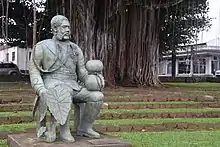Kalakaua Park
Kalākaua Park is the central "town square" of the city of Hilo, Hawaii. It is surrounded by historic buildings and includes a war memorial.


History
The area was originally the site of the first Christian Mission in the area known as Waiakea Mission Station-Hilo Station in 1825.[1] Later it evolved into the equivalent of a New England town square, surrounded by important civic buildings, such as the District Courthouse and Police Station,[2] and the U.S. Post Office and Office Building.
Federal Building
After the annexation of Territory of Hawaii in 1898, the United States government needed to build a Federal office building, in Hilo, the second-largest city in the territory.[3] However, funds were not available until 1913.[4] Designed to include the post office at the time, it was built on the square from 1915 to 1917. It was designed by Henry D. Whitfield, who was Andrew Carnegie's brother-in-law. It was in the Mediterranean neoclassic style with some modern touches such as open circulation with a large arcade. Unusual for Hawaii, it had a full basement, a raised first floor with high ceilings for the post office, a second floor for Federal court functions, and a clerestory band of oriel windows above the courtroom for natural lighting.[5]
In 1936, an addition in a similar style of was designed by Louis A. Simon to result in a "U" shape with two three-story wings. These were opened in 1938. The courtyard contains a flag pole, a mosaic-tiled fountain, and two decorative urns.[4] In 1978 most postal functions moved to a new building. In a 1979 interior renovation, the courthouse was converted to federal office space.[5]
The park
The park was named in honor of King David Kalākaua who ruled the Kingdom of Hawaii from 1874 to 1891, often called the "Merrie Monarch" because of his revival of Ancient Hawaiian song and dance. The Merrie Monarch Festival is a major cultural event held annually in Hilo. He dedicated the park around 1877.[5] It is located at 19°43′31″N 155°05′19″W, between Waianuenue Avenue and Kalakaua Street, and Kinoʻole Street and Keawe Street. Kinoʻole Street, originally Pitman Street, was named for Kinoʻole o Liliha Pitman. A bronze statue of Kalākaua in the middle of the park holds a taro leaf and ipu (gourd used in ancient chants). A time capsule was buried in 1991 during a total solar eclipse, to be opened in the next one to be visible here.[6]
War Memorial
A Vermont Danby Imperial white marble monument to those who died in World War II from the Island of Hawaiʻi was conceived in 1943 by the Hawaii Island Chamber of Commerce and completed in 1948. Charles William Dickey Associates were chosen as architects. They commissioned Sculptor Roy King of Honolulu to design and carve the monument. Donations came from the Hawaii American Legion Veterans, and Hawaii County. It is 10 feet (3.0 m) long, 4 feet (1.2 m) wide, and 6 feet (1.8 m) high. 157 names of Hawaiʻi Island World War II dead were inscribed on top. A lily pond reflects one side showing a central figure, a winged fighting man representing all combat forces. His wings signify protection and peace. On either side of him are people of the world living together in harmony. The back is inscribed “That their spirit may guide us to an ever living peace among all mankind.”[7]
At dedication October 31, 1948, Harold R. Warner, chairman of the Hawaii Island Chamber of Commerce memorial committee, turned the monument over to county chairman Clem A. Akina. Hundreds of residents stood in silence as Shojiro Takayama, who lost two sons in World War II, unveiled the monument. Veterans of the 442nd Infantry Regiment and 100th Infantry Battalion turned out. Unveiling ceremonies were followed by a procession to military services at the Veteran’s cemetery at (called Homelani) for four war dead returned from cemeteries in southern France and Italy. Maj. Hiro Higuchi, Army chaplain, formerly with the 442nd regiment officiated at the military services. Returning war dead were: Pfc. Satoshi Matsuoka, Pfc. Toshiaki Morimoto, Pvt. Setsuo Nagano, and Pfc. James K. Okamoto.[8]
Two plaques were added to opposite ends of the monument. One in memory of Hawaii County’s honored dead from the Korean War inscribed “Our deaths are not ours, they are yours. They will mean what you make them. Whether our lives and our deaths were for peace and a new hope or for nothing we cannot say. It is you who must say this.” The other in memory of Hawaii County’s honored dead of the Vietnam War inscribed “We leave you our deaths. Give them their meaning. Give them an end to the war and a true peace. Give them a victory that ends the war and a peace afterwards.” Because of these additions, this monument is often referred to as the Korean War Memorial.
Gallery
 The sundial donated by King Kalakaua
The sundial donated by King Kalakaua The time capsule of 1991 to be opened in 2106
The time capsule of 1991 to be opened in 2106 The Hawaii County War Memorial
The Hawaii County War Memorial
References
- Renee Von Elsner. "Haili Church Nomination form". National Register of Historic Places. National Park Service.
- Frances C. Sherrard. "District Courthouse and Police Station Nomination form". National Register of Historic Places. National Park Service.
- Report of the Governor of the Territory of Hawaii to the Secretary of the Interior. U.S. Government Printing Office. 1902. p. 141.
- "Federal Building, U.S. Post Office and Courthouse, Hilo, HI". U.S. General Services Administration web site.
- Randall J. Biallas and Gerron S. Kite (1973). "U.S. Post Office and Office Building Nomination form". National Register of Historic Places. National Park Service. Retrieved October 12, 2010.
- Kimberly Grant, Glenda Bendure (2005). Hawaii. Lonely Planet. p. 257. ISBN 978-1-74059-871-2.
- "Hawaii's War Memorial Monument, (sculpture)". Inventory of American Sculpture web site. Smithsonian American Art Museum. Retrieved 2010-04-24.
- Hilo Tribune-Herald. October 30 – November 1, 1948. Missing or empty
|title=(help)